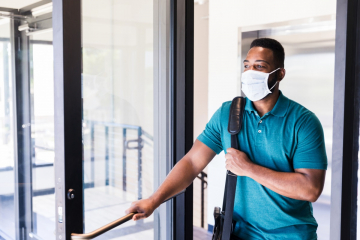On March 30, 2021 we welcomed close to 50 tech industry professionals from around the world to join us for a virtual EHSxTech meeting to discuss the ongoing changes and challenges of the COVID-19 pandemic.
As companies across the tech industry look at the past year of the pandemic and moving forward, the role of environmental, health and safety, and sustainability (EHS&S) leaders continues to evolve as they lead their companies forward. EHSxTech members were able to share and discuss ideas and experiences related to the ever-changing landscape of working in a pandemic. The discussion centered around returning to offices, home-based workers, vaccines, and the importance of communication.
Returning to the Office?
Across the globe, the discussion of returning to physical workplaces has been heating up and EHS is at the center of that discussion. EHSxTech members explored the challenges of planning next steps and what factors should be considered when making decisions on returning to work. “We see agility as a value. We have had to make a lot of pivots and decide what data to use and what controls knowing they can change so we review on a monthly basis or more, ” shared one EHSxTech leader. Some of the most important factors include the following:
- Guidelines set by the local and state governments: These guidelines are a good starting point for return-to-work decisions, keeping in mind that they will look different for each office location.
- The sentiment of local business leaders: Weighing the needs of local business leaders can help guide decision-making.
- Local COVID-19 ratings: Examining local data such as the number of cases, positive test percentage, hospital capacity, etc., can help gauge the risks associated with reopening offices.
- Peer company benchmarks: EHS leaders can learn from the actions of their industry peers, especially local actions, which will help in creating an effective strategy.
- Office preparedness: Most importantly, is the office safe to reoccupy and prepared to meet all health and safety requirements to keep employees safe?
One question worth serious consideration is - should we ever return to physical workspaces? The past year has proven that we have the capability to work from home successfully, especially in the tech industry. This question opens the door for companies to re-examine the traditional office structure and allow employees more flexibility in how they work, pending what the company needs are.
It is likely that even as employees return to work, the office will never look the same as it did before the pandemic. Many employees will take advantage of the opportunity to work remotely full- or part-time, changing the needs of the physical workspace and presenting new health and safety challenges.
Home-Based Workers
Many EHS tech leaders indicated their company expects to have a mix of work arrangements moving forward. Some employees will not be returning to the office and will be designated as permanent work-from-home employees (could be up to 40% for some companies). For employees that do return to the office, there is an acknowledgment that they may continue to work remotely a few days a week. This shift to a more permanent work from home structure means that health and safety must evolve. The EHSxTech discussion largely focused on three key areas that will require adjustment:
- Ergonomics: Ensuring remote employees have the knowledge and ability to set up an ergonomically correct workspace.
- Mental Health Resources: Expand benefits to include mental health resources that are readily available to employees working remotely.
- Safety Training: Work-from-home safety and emergency training should be developed along with existing safety training.
Given this new paradigm, it is expected that regulations surrounding remote employees will change in the coming months. EHS professionals will need to monitor regulatory code compliance closely and be prepared to adapt as needed. With companies that have a global presence, this becomes even more complex as different countries have very different regulations regarding home-based employees.
Continued communication with employees will be essential in planning the future structure of the physical workspace. While some employees will jump at the chance to return to an office, others may be slower to return or make working from home a permanent setup. A key to whatever work situation is best for an employee is making sure they feel safe and secure in their work environment.
Vaccines
Given vaccines are a relevant topic globally, it was expected that they would be a topic that is top-of-mind for EHSxTech leaders. There was a widespread sentiment in the virtual meeting that the current tech industry position is to “educate employees about vaccines and encourage employees to get vaccinated,” and some companies are looking at providing incentives for vaccination such as paid time off for vaccines and sick time for side effects.
Beyond that, there is a lack of clarity. It was the opinion of most EHS leaders that their company is waiting to see how the vaccine landscape unfolds over the next few weeks and months. Internal discussions are occurring but it is too soon to know if tech companies will adopt policies requiring vaccines for employees to return to the office or be approved for business travel. As it stands now, they will continue their education campaigns.
Communicating Expectations
EHSxTech leaders recognize that communication will be key to successfully navigate the post-pandemic return-to-work strategy. From keeping employees up to date on health and safety procedures to communicating expectations regarding vaccines, there must be a clear and present communication strategy. As we have seen over the past year and will continue to see moving forward, the strategy for handling the pandemic is constantly changing as local conditions change and new information is available. Effective and timely communication will keep employees safe and give them peace of mind during this transitionary period. Additionally, it will be important to ensure that there are systems that allow for two-way communication. Providing employees with ample opportunity to give feedback and voice concerns will help the return-to-work process run smoothly and ensure employees feel safe.
Closing Thoughts
As the discussion came to a close, one thing was clear: the roles and responsibilities of EHS leaders will continue to be extremely important in navigating the COVID-19 pandemic response and return to physical workspaces. Going forward, it will be critical to monitor the changing variables in the pandemic and listen to employees' wants and needs when planning a safe return-to-work strategy.
Learn more about how Antea Group can provide pandemic planning and return-to-work support.
Learn more about EHSxTech or contact us for more information.
Learn More About EHSxTechWant more news and insights like this?
Sign up for our monthly e-newsletter, The New Leaf. Our goal is to keep you updated, educated, and even a bit entertained as it relates to all things EHS and sustainability.
Get e-NewsletterHave any questions?
Contact us to discuss your environment, health, safety, and sustainability needs today.





